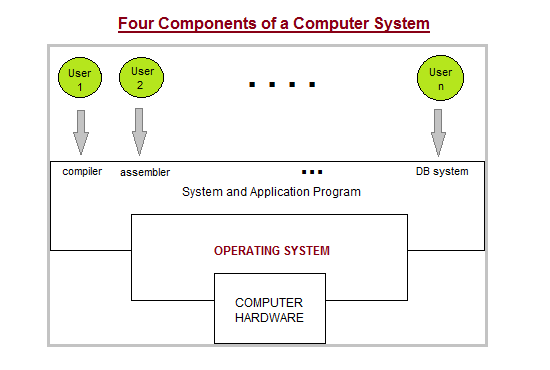Introduction To Computer Networks
Modern world scenario is ever changing. Data Communication and network have changed the way business and other daily affair works. Now, they highly rely on computer networks and internetwork.
A set of devices often mentioned as nodes connected by media link is called a Network.
A node can be a device which is capable of sending or receiving data generated by other nodes on the network like a computer, printer etc. These links connecting the devices are called Communication channels.
Computer network is a telecommunication channel using which we can share data with other coomputers or devices, connected to the same network. It is also called Data Network. The best example of computer network is Internet.
Computer network does not mean a system with one Control Unit connected to multiple other systems as its slave. That is Distributed system, not Computer Network.
A network must be able to meet certain criterias, these are mentioned below:
- Performance
- Reliability
- Scalability
Computer Networks: Performance
It can be measured in the following ways:
- Transit time : It is the time taken to travel a message from one device to another.
- Response time : It is defined as the time elapsed between enquiry and response.
Other ways to measure performance are :
- Efficiency of software
- Number of users
- Capability of connected hardware
Computer Networks: Reliability
It decides the frequency at which network failure take place. More the failures are, less is the network's reliability.
Computer Networks: Security
It refers to the protection of data from any unauthorised user or access. While travelling through network, data passes many layers of network, and data can be traced if attempted. Hence security is also a very important characteristic for Networks.
Properties of a Good Network
- Interpersonal Communication: We can communicate with each other efficiently and easily. Example: emails, chat rooms, video conferencing etc, all of these are possible because of computer networks.
- Resources can be shared: We can share physical resources by making them available on a network such as printers, scanners etc.
- Sharing files, data: Authorised users are allowed to share the files on the network.
Basic Communication Model
A Communication model is used to exchange data between two parties. For example: communication between a computer, server and telephone (through modem).

Communication Model: Source
Data to be transmitted is generated by this device, example: telephones, personal computers etc.
Communication Model: Transmitter
The data generated by the source system is not directly transmitted in the form its generated. The transmitter transforms and encodes the data in such a form to produce electromagnetic waves or signals.
Communication Model: Transmission System
A transmission system can be a single transmission line or a complex network connecting source and destination.
Communication Model: Receiver
Receiver accepts the signal from the transmission system and converts it into a form which is easily managed by the destination device.
Communication Model: Destination
Destination receives the incoming data from the receiver.
Data Communication
The exchange of data between two devices through a transmission medium is called Data Communication. The data is exchanged in the form of 0's and 1's. The transmission medium used is wire cable. For data communication to occur, the communication device must be a part of a communication system. Data Communication has two types - Local and Remote which are discussed below:
Data Communication: Local
Local communication takes place when the communicating devices are in the same geographical area, same building, or face-to-face etc.
Data Communication: Remote
Remote communication takes place over a distance i.e. the devices are farther. The effectiveness of a data communication can be measured through the following features :
- Delivery: Delivery should be done to the correct destination.
- Timeliness: Delivery should be on time.
- Accuracy: Data delivered should be accurate.
Components of Data Communication
- Message: It is the information to be delivered.
- Sender: Sender is the person who is sending the message.
- Receiver: Receiver is the person to whom the message is being sent to.
- Medium: It is the medium through which the message is sent. For example: A Modem.
- Protocol: These are some set of rules which govern data communication.
Uses of Computer Networks
Had it not been of high importance, nobody would have bothered connecting computers over a network. Let's start exploring the uses of Computer Networks with some traditional usecases at companies and for individuals and then move on to the recent developments in the area of mobile users and home networking.
Computer Networks: Business Applications
Following are some business applications of computer networks:
1. Resource Sharing:
The goal is to make all programs, equipments(like printers etc), and especially data, available to anyone on the network without regard to the physical location of the resource and the user.
2. Server-Client model:
One can imagine a company's information system as consisting of one or more databases and some employees who need to access it remotely. In this model, the data is stored on powerful computers called Servers. Often these are centrally housed and maintained by a system administrator. In contrast, the employees have simple machines, called Clients, on their desks, using which they access remote data.
3. Communication Medium:
A computer network can provide a powerful communication medium among employees. Virtually every company that has two or more computers now has e-mail (electronic mail), which employees generally use for a great deal of daily communication
4. eCommerce:
A goal that is starting to become more important in businesses is doing business with consumers over the Internet. Airlines, bookstores and music vendors have discovered that many customers like the convenience of shopping from home. This sector is expected to grow quickly in the future.
The most popular forms are listed in the below figure:
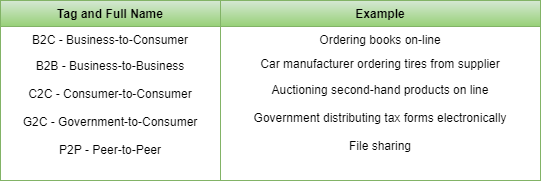
Computer Networks: Home Applications
Some of the most important uses of the Internet for home users are as follows:
- Access to remote information
- Person-to-person communication
- Interactive entertainment
- Electronic commerce
Computer Networks: Mobile Users
Mobile computers, such as notebook computers and Mobile phones, is one of the fastest-growing segment of the entire computer industry. Although wireless networking and mobile computing are often related, they are not identical, as the below figure shows.

Line Configuration in Computer Networks
A Network is nothing but a connection made through connection links between two or more devices. Devices can be a computer, printer or any other device that is capable to send and receive data. There are two ways to connect the devices :
- Point-to-Point connection
- Multipoint connection
Point-To-Point Connection
It is a protocol which is used as a communication link between two devices. It is simple to establish. The most common example for Point-to-Point connection (PPP) is a computer connected by telephone line. We can connect the two devices by means of a pair of wires or using a microwave or satellite link.
Example: Point-to-Point connection between remote control and Television for changing the channels.


MultiPoint Connection
It is also called Multidrop configuration. In this connection two or more devices share a single link.
There are two kinds of Multipoint Connections :
- If the links are used simultaneously between many devices, then it is spatially shared line configuration.
- If user takes turns while using the link, then it is time shared (temporal) line configuration.

Types of Network Topology
Network Topology is the schematic description of a network arrangement, connecting various nodes(sender and receiver) through lines of connection.
BUS Topology
Bus topology is a network type in which every computer and network device is connected to single cable. When it has exactly two endpoints, then it is called Linear Bus topology.

Features of Bus Topology
- It transmits data only in one direction.
- Every device is connected to a single cable
Advantages of Bus Topology
- It is cost effective.
- Cable required is least compared to other network topology.
- Used in small networks.
- It is easy to understand.
- Easy to expand joining two cables together.
Disadvantages of Bus Topology
- Cables fails then whole network fails.
- If network traffic is heavy or nodes are more the performance of the network decreases.
- Cable has a limited length.
- It is slower than the ring topology.
RING Topology
It is called ring topology because it forms a ring as each computer is connected to another computer, with the last one connected to the first. Exactly two neighbours for each device.
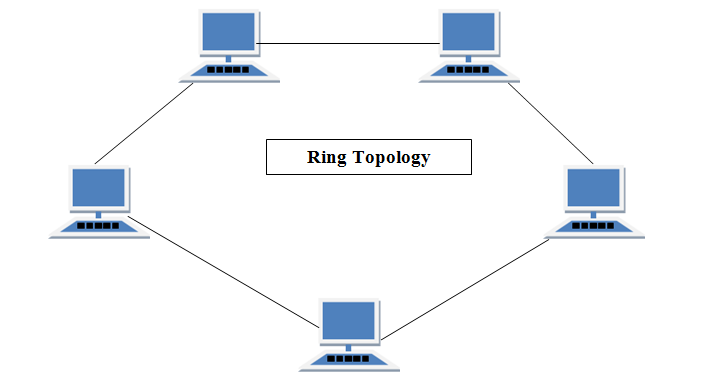
Features of Ring Topology
- A number of repeaters are used for Ring topology with large number of nodes, because if someone wants to send some data to the last node in the ring topology with 100 nodes, then the data will have to pass through 99 nodes to reach the 100th node. Hence to prevent data loss repeaters are used in the network.
- The transmission is unidirectional, but it can be made bidirectional by having 2 connections between each Network Node, it is called Dual Ring Topology.
- In Dual Ring Topology, two ring networks are formed, and data flow is in opposite direction in them. Also, if one ring fails, the second ring can act as a backup, to keep the network up.
- Data is transferred in a sequential manner that is bit by bit. Data transmitted, has to pass through each node of the network, till the destination node.
Advantages of Ring Topology
- Transmitting network is not affected by high traffic or by adding more nodes, as only the nodes having tokens can transmit data.
- Cheap to install and expand
Disadvantages of Ring Topology
- Troubleshooting is difficult in ring topology.
- Adding or deleting the computers disturbs the network activity.
- Failure of one computer disturbs the whole network.
STAR Topology
In this type of topology all the computers are connected to a single hub through a cable. This hub is the central node and all others nodes are connected to the central node.

Features of Star Topology
- Every node has its own dedicated connection to the hub.
- Hub acts as a repeater for data flow.
- Can be used with twisted pair, Optical Fibre or coaxial cable.
Advantages of Star Topology
- Fast performance with few nodes and low network traffic.
- Hub can be upgraded easily.
- Easy to troubleshoot.
- Easy to setup and modify.
- Only that node is affected which has failed, rest of the nodes can work smoothly.
Disadvantages of Star Topology
- Cost of installation is high.
- Expensive to use.
- If the hub fails then the whole network is stopped because all the nodes depend on the hub.
- Performance is based on the hub that is it depends on its capacity
MESH Topology
It is a point-to-point connection to other nodes or devices. All the network nodes are connected to each other. Mesh has
n(n-1)/2 physical channels to link n devices.
There are two techniques to transmit data over the Mesh topology, they are :
- Routing
- Flooding
MESH Topology: Routing
In routing, the nodes have a routing logic, as per the network requirements. Like routing logic to direct the data to reach the destination using the shortest distance. Or, routing logic which has information about the broken links, and it avoids those node etc. We can even have routing logic, to re-configure the failed nodes.
MESH Topology: Flooding
In flooding, the same data is transmitted to all the network nodes, hence no routing logic is required. The network is robust, and the its very unlikely to lose the data. But it leads to unwanted load over the network.
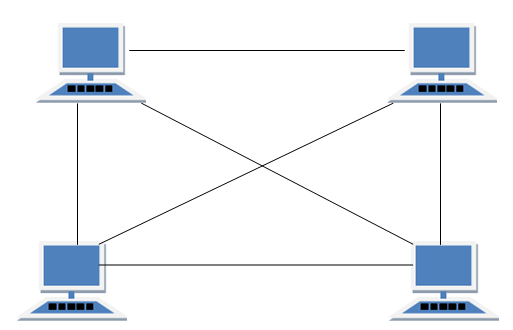
Types of Mesh Topology
- Partial Mesh Topology : In this topology some of the systems are connected in the same fashion as mesh topology but some devices are only connected to two or three devices.
- Full Mesh Topology : Each and every nodes or devices are connected to each other.
Features of Mesh Topology
- Fully connected.
- Robust.
- Not flexible.
Advantages of Mesh Topology
- Each connection can carry its own data load.
- It is robust.
- Fault is diagnosed easily.
- Provides security and privacy.
Disadvantages of Mesh Topology
- Installation and configuration is difficult.
- Cabling cost is more.
- Bulk wiring is required.
TREE Topology
It has a root node and all other nodes are connected to it forming a hierarchy. It is also called hierarchical topology. It should at least have three levels to the hierarchy.

Features of Tree Topology
- Ideal if workstations are located in groups.
- Used in Wide Area Network.
Advantages of Tree Topology
- Extension of bus and star topologies.
- Expansion of nodes is possible and easy.
- Easily managed and maintained.
- Error detection is easily done.
Disadvantages of Tree Topology
- Heavily cabled.
- Costly.
- If more nodes are added maintenance is difficult.
- Central hub fails, network fails.
HYBRID Topology
It is two different types of topologies which is a mixture of two or more topologies. For example if in an office in one department ring topology is used and in another star topology is used, connecting these topologies will result in Hybrid Topology (ring topology and star topology).
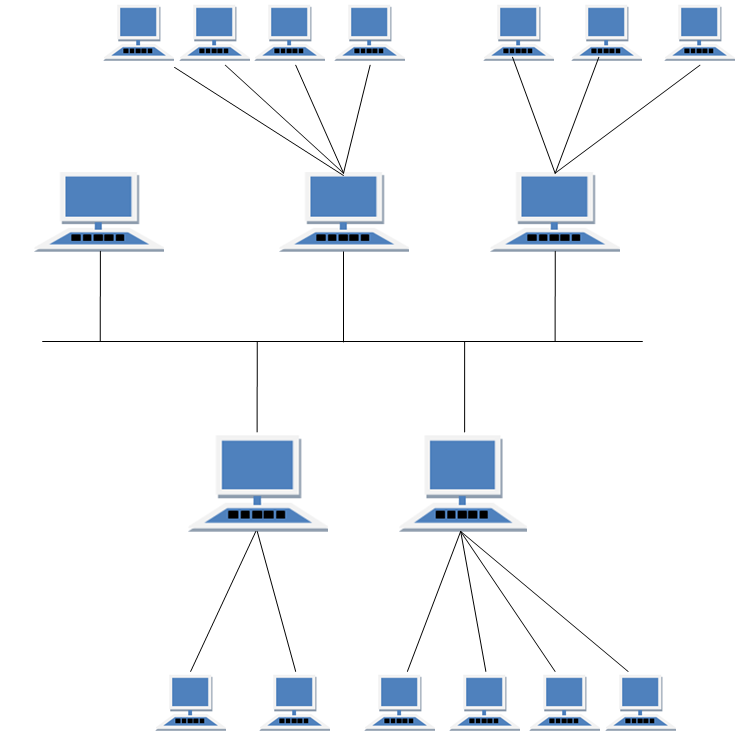
Features of Hybrid Topology
- It is a combination of two or topologies
- Inherits the advantages and disadvantages of the topologies included
Advantages of Hybrid Topology
- Reliable as Error detecting and trouble shooting is easy.
- Effective.
- Scalable as size can be increased easily.
- Flexible.
Disadvantages of Hybrid Topology
- Complex in design.
- Costly.
Transmission Modes in Computer Networks
Transmission mode refers to the mechanism of transferring of data between two devices connected over a network. It is also called Communication Mode. These modes direct the direction of flow of information. There are three types of transmission modes. They are:
- Simplex Mode
- Half duplex Mode
- Full duplex Mode

SIMPLEX Mode
In this type of transmission mode, data can be sent only in one direction i.e. communication is unidirectional. We cannot send a message back to the sender. Unidirectional communication is done in Simplex Systems where we just need to send a command/signal, and do not expect any response back.
Examples of simplex Mode are loudspeakers, television broadcasting, television and remote, keyboard and monitor etc.

HALF DUPLEX Mode
Half-duplex data transmission means that data can be transmitted in both directions on a signal carrier, but not at the same time.
For example, on a local area network using a technology that has half-duplex transmission, one workstation can send data on the line and then immediately receive data on the line from the same direction in which data was just transmitted. Hence half-duplex transmission implies a bidirectional line (one that can carry data in both directions) but data can be sent in only one direction at a time.
Example of half duplex is a walkie- talkie in which message is sent one at a time but messages are sent in both the directions.

FULL DUPLEX Mode
In full duplex system we can send data in both the directions as it is bidirectional at the same time in other words, data can be sent in both directions simultaneously.
Example of Full Duplex is a Telephone Network in which there is communication between two persons by a telephone line, using which both can talk and listen at the same time.

In full duplex system there can be two lines one for sending the data and the other for receiving data.

Transmission Mediums in Computer Networks
Data is represented by computers and other telecommunication devices using signals. Signals are transmitted in the form of electromagnetic energy from one device to another. Electromagnetic signals travel through vacuum, air or other transmission mediums to move from one point to another(from sender to receiver).
Electromagnetic energy (includes electrical and magnetic fields) consists of power, voice, visible light, radio waves, ultraviolet light, gamma rays etc.
Transmission medium is the means through which we send our data from one place to another. The first layer (physical layer) of Communication Networks OSI Seven layer model is dedicated to the transmission media, we will study the OSI Model later.

Factors to be considered while selecting a Transmission Medium
- Transmission Rate
- Cost and Ease of Installation
- Resistance to Environmental Conditions
- Distances
Bounded or Guided Transmission Media
Guided media, which are those that provide a conduit from one device to another, include Twisted-Pair Cable, Coaxial Cable, and Fibre-Optic Cable.
A signal travelling along any of these media is directed and contained by the physical limits of the medium. Twisted-pair and coaxial cable use metallic (copper) conductors that accept and transport signals in the form of electric current. Optical fibre is a cable that accepts and transports signals in the form of light.
Twisted Pair Cable
This cable is the most commonly used and is cheaper than others. It is lightweight, cheap, can be installed easily, and they support many different types of network. Some important points :
- Its frequency range is 0 to 3.5 kHz.
- Typical attenuation is 0.2 dB/Km @ 1kHz.
- Typical delay is 50 µs/km.
- Repeater spacing is 2km.
A twisted pair consists of two conductors(normally copper), each with its own plastic insulation, twisted together. One of these wires is used to carry signals to the receiver, and the other is used only as ground reference. The receiver uses the difference between the two. In addition to the signal sent by the sender on one of the wires, interference(noise) and crosstalk may affect both wires and create unwanted signals. If the two wires are parallel, the effect of these unwanted signals is not the same in both wires because they are at different locations relative to the noise or crosstalk sources. This results in a difference at the receiver.
Twisted Pair is of two types:
- Unshielded Twisted Pair (UTP)
- Shielded Twisted Pair (STP)
Unshielded Twisted Pair Cable
It is the most common type of telecommunication when compared with Shielded Twisted Pair Cable which consists of two conductors usually copper, each with its own colour plastic insulator. Identification is the reason behind coloured plastic insulation.
UTP cables consist of 2 or 4 pairs of twisted cable. Cable with 2 pair use RJ-11 connector and 4 pair cable use RJ-45 connector.

Advantages of Unshielded Twisted Pair Cable
- Installation is easy
- Flexible
- Cheap
- It has high speed capacity,
- 100 meter limit
- Higher grades of UTP are used in LAN technologies like Ethernet.
It consists of two insulating copper wires (1mm thick). The wires are twisted together in a helical form to reduce electrical interference from similar pair.
Disadvantages of Unshielded Twisted Pair Cable
- Bandwidth is low when compared with Coaxial Cable
- Provides less protection from interference.
Shielded Twisted Pair Cable
This cable has a metal foil or braided-mesh covering which encases each pair of insulated conductors. Electromagnetic noise penetration is prevented by metal casing. Shielding also eliminates crosstalk (explained in KEY TERMS Chapter).
It has same attenuation as unshielded twisted pair. It is faster the unshielded and coaxial cable. It is more expensive than coaxial and unshielded twisted pair.

Advantages of Shielded Twisted Pair Cable
- Easy to install
- Performance is adequate
- Can be used for Analog or Digital transmission
- Increases the signalling rate
- Higher capacity than unshielded twisted pair
- Eliminates crosstalk
Disadvantages of Shielded Twisted Pair Cable
- Difficult to manufacture
- Heavy
Performance of Shielded Twisted Pair Cable
One way to measure the performance of twisted-pair cable is to compare attenuation versus frequency and distance. As shown in the below figure, a twisted-pair cable can pass a wide range of frequencies. However, with increasing frequency, the attenuation, measured in decibels per kilometre (dB/km), sharply increases with frequencies above 100kHz. Note that gauge is a measure of the thickness of the wire.

Applications of Shielded Twisted Pair Cable
- In telephone lines to provide voice and data channels. The DSL lines that are used by the telephone companies to provide high-data-rate connections also use the high-bandwidth capability of unshielded twisted-pair cables.
- Local Area Network, such as 10Base-T and 100Base-T, also use twisted-pair cables.
Coaxial Cable
Coaxial is called by this name because it contains two conductors that are parallel to each other. Copper is used in this as centre conductor which can be a solid wire or a standard one. It is surrounded by PVC installation, a sheath which is encased in an outer conductor of metal foil, barid or both.
Outer metallic wrapping is used as a shield against noise and as the second conductor which completes the circuit. The outer conductor is also encased in an insulating sheath. The outermost part is the plastic cover which protects the whole cable.
Here the most common coaxial standards.
- 50-Ohm RG-7 or RG-11 : used with thick Ethernet.
- 50-Ohm RG-58 : used with thin Ethernet
- 75-Ohm RG-59 : used with cable television
- 93-Ohm RG-62 : used with ARCNET.

Coaxial Cable Standards
Coaxial cables are categorized by their Radio Government(RG) ratings. Each RG number denotes a unique set of physical specifications, including the wire gauge of the inner conductor, the thickness and the type of the inner insulator, the construction of the shield, and the size and type of the outer casing. Each cable defined by an RG rating is adapted for a specialized function, as shown in the table below:

Coaxial Cable Connectors
To connect coaxial cable to devices, we need coaxial connectors. The most common type of connector used today is the Bayonet Neill-Concelman (BNC) connector. The below figure shows 3 popular types of these connectors: the BNC Connector, the BNC T connector and the BNC terminator.

The BNC connector is used to connect the end of the cable to the device, such as a TV set. The BNC T connector is used in Ethernet networks to branch out to a connection to a computer or other device. The BNC terminator is used at the end of the cable to prevent the reflection of the signal.
There are two types of Coaxial cables:
1. BaseBand
This is a 50 ohm (Ω) coaxial cable which is used for digital transmission. It is mostly used for LAN's. Baseband transmits a single signal at a time with very high speed. The major drawback is that it needs amplification after every 1000 feet.
2. BroadBand
This uses analog transmission on standard cable television cabling. It transmits several simultaneous signal using different frequencies. It covers large area when compared with Baseband Coaxial Cable.
Advantages of Coaxial Cable
- Bandwidth is high
- Used in long distance telephone lines.
- Transmits digital signals at a very high rate of 10Mbps.
- Much higher noise immunity
- Data transmission without distortion.
- The can span to longer distance at higher speeds as they have better shielding when compared to twisted pair cable
Disadvantages of Coaxial Cable
- Single cable failure can fail the entire network.
- Difficult to install and expensive when compared with twisted pair.
- If the shield is imperfect, it can lead to grounded loop.
Performance of Coaxial Cable
We can measure the performance of a coaxial cable in same way as that of Twisted Pair Cables. From the below figure, it can be seen that the attenuation is much higher in coaxial cable than in twisted-pair cable. In other words, although coaxial cable has a much higher bandwidth, the signal weakens rapidly and requires the frequent use of repeaters.

Applications of Coaxial Cable
- Coaxial cable was widely used in analog telephone networks, where a single coaxial network could carry 10,000 voice signals.
- Cable TV networks also use coaxial cables. In the traditional cable TV network, the entire network used coaxial cable. Cable TV uses RG-59 coaxial cable.
- In traditional Ethernet LANs. Because of it high bandwidth, and consequence high data rate, coaxial cable was chosen for digital transmission in early Ethernet LANs. The 10Base-2, or Thin Ethernet, uses RG-58 coaxial cable with BNC connectors to transmit data at 10Mbps with a range of 185 m.
Fiber Optic Cable
A fibre-optic cable is made of glass or plastic and transmits signals in the form of light.
For better understanding we first need to explore several aspects of the nature of light.
Light travels in a straight line as long as it is mobbing through a single uniform substance. If ray of light travelling through one substance suddenly enters another substance (of a different density), the ray changes direction.
The below figure shows how a ray of light changes direction when going from a more dense to a less dense substance.

Bending of a light ray
As the figure shows:
- If the angle of incidence I(the angle the ray makes with the line perpendicular to the interface between the two substances) is less than the critical angle, the ray refracts and moves closer to the surface.
- If the angle of incidence is greater than the critical angle, the ray reflects(makes a turn) and travels again in the denser substance.
- If the angle of incidence is equal to the critical angle, the ray refracts and moves parallel to the surface as shown.
Note: The critical angle is a property of the substance, and its value differs from one substance to another.
Optical fibres use reflection to guide light through a channel. A glass or plastic core is surrounded by a cladding of less dense glass or plastic. The difference in density of the two materials must be such that a beam of light moving through the core is reflected off the cladding instead of being refracted into it.

Internal view of an Optical fibre
Propagation Modes of Fiber Optic Cable
Current technology supports two modes(Multimode and Single mode) for propagating light along optical channels, each requiring fibre with different physical characteristics. Multimode can be implemented in two forms: Step-index and Graded-index.

Multimode Propagation Mode
Multimode is so named because multiple beams from a light source move through the core in different paths. How these beams move within the cable depends on the structure of the core as shown in the below figure.

- In multimode step-index fibre, the density of the core remains constant from the centre to the edges. A beam of light moves through this constant density in a straight line until it reaches the interface of the core and the cladding.
The term step-index refers to the suddenness of this change, which contributes to the distortion of the signal as it passes through the fibre. - In multimode graded-index fibre, this distortion gets decreases through the cable. The word index here refers to the index of refraction. This index of refraction is related to the density. A graded-index fibre, therefore, is one with varying densities. Density is highest at the centre of the core and decreases gradually to its lowest at the edge.
Single Mode
Single mode uses step-index fibre and a highly focused source of light that limits beams to a small range of angles, all close to the horizontal. The single-mode fibre itself is manufactured with a much smaller diameter than that of multimode fibre, and with substantially lower density.
The decrease in density results in a critical angle that is close enough to 90 degree to make the propagation of beams almost horizontal.
The decrease in density results in a critical angle that is close enough to 90 degree to make the propagation of beams almost horizontal.
Fibre Sizes for Fiber Optic Cable
Optical fibres are defined by the ratio of the diameter or their core to the diameter of their cladding, both expressed in micrometers. The common sizes are shown in the figure below:

Fibre Optic Cable Connectors
There are three types of connectors for fibre-optic cables, as shown in the figure below.

The Subscriber Channel(SC) connector is used for cable TV. It uses push/pull locking system. The Straight-Tip(ST) connector is used for connecting cable to the networking devices. MT-RJ is a connector that is the same size as RJ45.
Advantages of Fibre Optic Cable
Fibre optic has several advantages over metallic cable:
- Higher bandwidth
- Less signal attenuation
- Immunity to electromagnetic interference
- Resistance to corrosive materials
- Light weight
- Greater immunity to tapping
Disadvantages of Fibre Optic Cable
There are some disadvantages in the use of optical fibre:
- Installation and maintenance
- Unidirectional light propagation
- High Cost
Performance of Fibre Optic Cable
Attenuation is flatter than in the case of twisted-pair cable and coaxial cable. The performance is such that we need fewer(actually one tenth as many) repeaters when we use the fibre-optic cable.
Applications of Fibre Optic Cable
- Often found in backbone networks because its wide bandwidth is cost-effective.
- Some cable TV companies use a combination of optical fibre and coaxial cable thus creating a hybrid network.
- Local-area Networks such as 100Base-FX network and 1000Base-X also use fibre-optic cable.
UnBounded or UnGuided Transmission Media
Unguided medium transport electromagnetic waves without using a physical conductor. This type of communication is often referred to as wireless communication. Signals are normally broadcast through free space and thus are available to anyone who has a device capable of receiving them.
The below figure shows the part of the electromagnetic spectrum, ranging from 3 kHz to 900 THz, used for wireless communication.

Unguided signals can travel from the source to the destination in several ways: Gound propagation, Sky propagation and Line-of-sight propagation as shown in below figure.
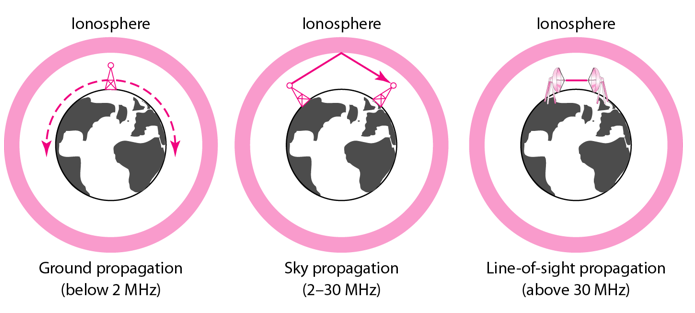
Propagation Modes
- Ground Propagation: In this, radio waves travel through the lowest portion of the atmosphere, hugging the Earth. These low-frequency signals emanate in all directions from the transmitting antenna and follow the curvature of the planet.
- Sky Propagation: In this, higher-frequency radio waves radiate upward into the ionosphere where they are reflected back to Earth. This type of transmission allows for greater distances with lower output power.
- Line-of-sight Propagation: in this type, very high-frequency signals are transmitted in straight lines directly from antenna to antenna.
We can divide wireless transmission into three broad groups:
- Radio waves
- Micro waves
- Infrared waves
Radio Waves
Electromagnetic waves ranging in frequencies between 3 KHz and 1 GHz are normally called radio waves.
Radio waves are omnidirectional. When an antenna transmits radio waves, they are propagated in all directions. This means that the sending and receiving antennas do not have to be aligned. A sending antenna send waves that can be received by any receiving antenna. The omnidirectional property has disadvantage, too. The radio waves transmitted by one antenna are susceptible to interference by another antenna that may send signal suing the same frequency or band.
Radio waves, particularly with those of low and medium frequencies, can penetrate walls. This characteristic can be both an advantage and a disadvantage. It is an advantage because, an AM radio can receive signals inside a building. It is a disadvantage because we cannot isolate a communication to just inside or outside a building.
Omnidirectional Antenna for Radio Waves
Radio waves use omnidirectional antennas that send out signals in all directions.
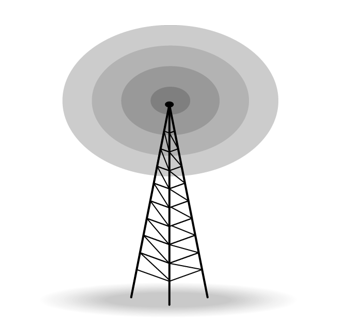
Applications of Radio Waves
- The omnidirectional characteristics of radio waves make them useful for multicasting in which there is one sender but many receivers.
- AM and FM radio, television, maritime radio, cordless phones, and paging are examples of multicasting.
Micro Waves
Electromagnetic waves having frequencies between 1 and 300 GHz are called micro waves. Micro waves are unidirectional. When an antenna transmits microwaves, they can be narrowly focused. This means that the sending and receiving antennas need to be aligned. The unidirectional property has an obvious advantage. A pair of antennas can be aligned without interfering with another pair of aligned antennas.
The following describes some characteristics of microwaves propagation:
- Microwave propagation is line-of-sight. Since the towers with the mounted antennas need to be in direct sight of each other, towers that are far apart need to be very tall.
- Very high-frequency microwaves cannot penetrate walls. This characteristic can be a disadvantage if receivers are inside the buildings.
- The microwave band is relatively wide, almost 299 GHz. Therefore, wider sub-bands can be assigned and a high date rate is possible.
- Use of certain portions of the band requires permission from authorities.
Unidirectional Antenna for Micro Waves
Microwaves need unidirectional antennas that send out signals in one direction. Two types of antennas are used for microwave communications: Parabolic Dish and Horn.
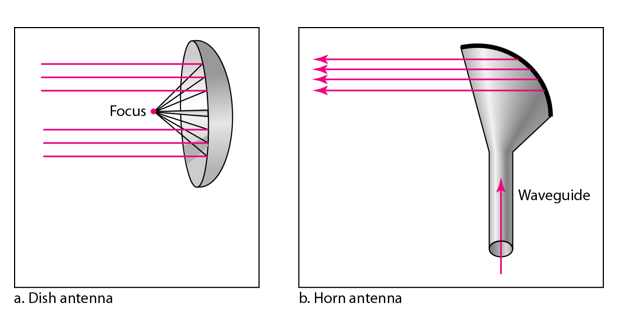
A parabolic antenna works as a funnel, catching a wide range of waves and directing them to a common point. In this way, more of the signal is recovered than would be possible with a single-point receiver.
A horn antenna looks like a gigantic scoop. Outgoing transmissions are broadcast up a stem and deflected outward in a series of narrow parallel beams by the curved head. Received transmissions are collected by the scooped shape of the horn, in a manner similar to the parabolic dish, and are deflected down into the stem.
Applications of Micro Waves
Microwaves, due to their unidirectional properties, are very useful when unicast(one-to-one) communication is needed between the sender and the receiver. They are used in cellular phones, satellite networks and wireless LANs.
There are 2 types of Microwave Transmission :
- Terrestrial Microwave
- Satellite Microwave
Advantages of Microwave Transmission
- Used for long distance telephone communication
- Carries 1000's of voice channels at the same time
Disadvantages of Microwave Transmission
- It is very costly
Terrestrial Microwave
For increasing the distance served by terrestrial microwave, repeaters can be installed with each antenna .The signal received by an antenna can be converted into transmittable form and relayed to next antenna as shown in below figure. It is an example of telephone systems all over the world

There are two types of antennas used for terrestrial microwave communication :
1. Parabolic Dish Antenna
In this every line parallel to the line of symmetry reflects off the curve at angles in a way that they intersect at a common point called focus. This antenna is based on geometry of parabola.

2. Horn Antenna
It is a like gigantic scoop. The outgoing transmissions are broadcast up a stem and deflected outward in a series of narrow parallel beams by curved head.

Satellite Microwave
This is a microwave relay station which is placed in outer space. The satellites are launched either by rockets or space shuttles carry them.
These are positioned 36000 Km above the equator with an orbit speed that exactly matches the rotation speed of the earth. As the satellite is positioned in a geo-synchronous orbit, it is stationery relative to earth and always stays over the same point on the ground. This is usually done to allow ground stations to aim antenna at a fixed point in the sky.

Features of Satellite Microwave
- Bandwidth capacity depends on the frequency used.
- Satellite microwave deployment for orbiting satellite is difficult.
Advantages of Satellite Microwave
- Transmitting station can receive back its own transmission and check whether the satellite has transmitted information correctly.
- A single microwave relay station which is visible from any point.
Disadvantages of Satellite Microwave
- Satellite manufacturing cost is very high
- Cost of launching satellite is very expensive
- Transmission highly depends on whether conditions, it can go down in bad weather
Infrared Waves
Infrared waves, with frequencies from 300 GHz to 400 THz, can be used for short-range communication. Infrared waves, having high frequencies, cannot penetrate walls. This advantageous characteristic prevents interference between one system and another, a short-range communication system in on room cannot be affected by another system in the next room.
When we use infrared remote control, we do not interfere with the use of the remote by our neighbours. However, this same characteristic makes infrared signals useless for long-range communication. In addition, we cannot use infrared waves outside a building because the sun's rays contain infrared waves that can interfere with the communication.
Applications of Infrared Waves
- The infrared band, almost 400 THz, has an excellent potential for data transmission. Such a wide bandwidth can be used to transmit digital data with a very high data rate.
- The Infrared Data Association(IrDA), an association for sponsoring the use of infrared waves, has established standards for using these signals for communication between devices such as keyboards, mouse, PCs and printers.
- Infrared signals can be used for short-range communication in a closed area using line-of-sight propagation.
Types of Communication Networks
Communication Networks can be of following 5 types:
- Local Area Network (LAN)
- Metropolitan Area Network (MAN)
- Wide Area Network (WAN)
- Wireless
- Inter Network (Internet)

Local Area Network (LAN)
It is also called LAN and designed for small physical areas such as an office, group of buildings or a factory. LANs are used widely as it is easy to design and to troubleshoot. Personal computers and workstations are connected to each other through LANs. We can use different types of topologies through LAN, these are Star, Ring, Bus, Tree etc.
LAN can be a simple network like connecting two computers, to share files and network among each other while it can also be as complex as interconnecting an entire building.
LAN networks are also widely used to share resources like printers, shared hard-drive etc.
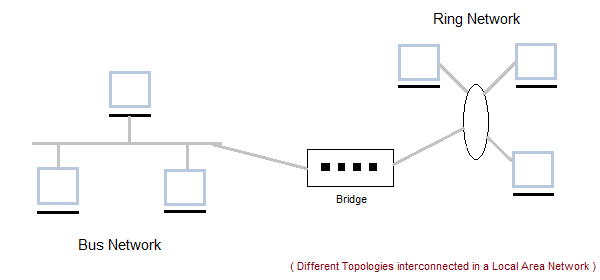
Characteristics of LAN
- LAN's are private networks, not subject to tariffs or other regulatory controls.
- LAN's operate at relatively high speed when compared to the typical WAN.
- There are different types of Media Access Control methods in a LAN, the prominent ones are Ethernet, Token ring.
- It connects computers in a single building, block or campus, i.e. they work in a restricted geographical area.
Applications of LAN
- One of the computer in a network can become a server serving all the remaining computers called clients. Software can be stored on the server and it can be used by the remaining clients.
- Connecting Locally all the workstations in a building to let them communicate with each other locally without any internet access.
- Sharing common resources like printers etc are some common applications of LAN.
Advantages of LAN
- Resource Sharing: Computer resources like printers, modems, DVD-ROM drives and hard disks can be shared with the help of local area networks. This reduces cost and hardware purchases.
- Software Applications Sharing: It is cheaper to use same software over network instead of purchasing separate licensed software for each client a network.
- Easy and Cheap Communication: Data and messages can easily be transferred over networked computers.
- Centralized Data: The data of all network users can be saved on hard disk of the server computer. This will help users to use any workstation in a network to access their data. Because data is not stored on workstations locally.
- Data Security: Since, data is stored on server computer centrally, it will be easy to manage data at only one place and the data will be more secure too.
- Internet Sharing: Local Area Network provides the facility to share a single internet connection among all the LAN users. In Net Cafes, single internet connection sharing system keeps the internet expenses cheaper.
Disadvantages of LAN
- High Setup Cost: Although the LAN will save cost over time due to shared computer resources, but the initial setup costs of installing Local Area Networks is high.
- Privacy Violations: The LAN administrator has the rights to check personal data files of each and every LAN user. Moreover he can check the internet history and computer use history of the LAN user.
- Data Security Threat: Unauthorised users can access important data of an organization if centralized data repository is not secured properly by the LAN administrator.
- LAN Maintenance Job: Local Area Network requires a LAN Administrator because, there are problems of software installations or hardware failures or cable disturbances in Local Area Network. A LAN Administrator is needed at this full time job.
- Covers Limited Area: Local Area Network covers a small area like one office, one building or a group of nearby buildings.
Metropolitan Area Network (MAN)
It was developed in 1980s.It is basically a bigger version of LAN. It is also called MAN and uses the similar technology as LAN. It is designed to extend over the entire city. It can be means to connecting a number of LANs into a larger network or it can be a single cable. It is mainly hold and operated by single private company or a public company.
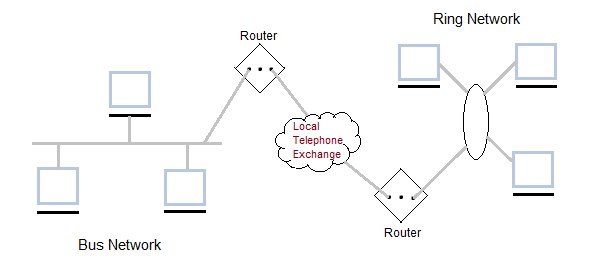
Characteristics of MAN
- It generally covers towns and cities (50 km)
- Communication medium used for MAN are optical fibers, cables etc.
- Data rates adequate for distributed computing applications.
Advantages of MAN
- Extremely efficient and provide fast communication via high-speed carriers, such as fibre optic cables.
- It provides a good back bone for large network and provides greater access to WANs.
- The dual bus used in MAN helps the transmission of data in both directions simultaneously.
- A MAN usually encompasses several blocks of a city or an entire city.
Disadvantages of MAN
- More cable required for a MAN connection from one place to another.
- It is difficult to make the system secure from hackers and industrial espionage(spying) graphical regions.
Wide Area Network (WAN)
It is also called WAN. WAN can be private or it can be public leased network. It is used for the network that covers large distance such as cover states of a country. It is not easy to design and maintain. Communication medium used by WAN are PSTN or Satellite links. WAN operates on low data rates.

Characteristics of WAN
- It generally covers large distances(states, countries, continents).
- Communication medium used are satellite, public telephone networks which are connected by routers.
Advantages of WAN
- Covers a large geographical area so long distance business can connect on the one network.
- Shares software and resources with connecting workstations.
- Messages can be sent very quickly to anyone else on the network. These messages can have picture, sounds or data included with them(called attachments).
- Expensive things(such as printers or phone lines to the internet) can be shared by all the computers on the network without having to buy a different peripheral for each computer.
- Everyone on the network can use the same data. This avoids problems where some users may have older information than others.
Disadvantages of WAN
- Need a good firewall to restrict outsiders from entering and disrupting the network.
- Setting up a network can be an expensive, slow and complicated. The bigger the network the more expensive it is.
- Once set up, maintaining a network is a full-time job which requires network supervisors and technicians to be employed.
- Security is a real issue when many different people have the ability to use information from other computers. Protection against hackers and viruses adds more complexity and expense.
Wireless Network
Digital wireless communication is not a new idea. Earlier, Morse code was used to implement wireless networks. Modern digital wireless systems have better performance, but the basic idea is the same.
Wireless Networks can be divided into three main categories:
- System interconnection
- Wireless LANs
- Wireless WANs
System Interconnection
System interconnection is all about interconnecting the components of a computer using short-range radio. Some companies got together to design a short-range wireless network called Bluetooth to connect various components such as monitor, keyboard, mouse and printer, to the main unit, without wires. Bluetooth also allows digital cameras, headsets, scanners and other devices to connect to a computer by merely being brought within range.
In simplest form, system interconnection networks use the master-slave concept. The system unit is normally the master, talking to the mouse, keyboard, etc. as slaves.
Wireless LANs
These are the systems in which every computer has a radio modem and antenna with which it can communicate with other systems. Wireless LANs are becoming increasingly common in small offices and homes, where installing Ethernet is considered too much trouble. There is a standard for wireless LANs called IEEE 802.11, which most systems implement and which is becoming very widespread.
Wireless WANs
The radio network used for cellular telephones is an example of a low-bandwidth wireless WAN. This system has already gone through three generations.
- The first generation was analog and for voice only.
- The second generation was digital and for voice only.
- The third generation is digital and is for both voice and data.
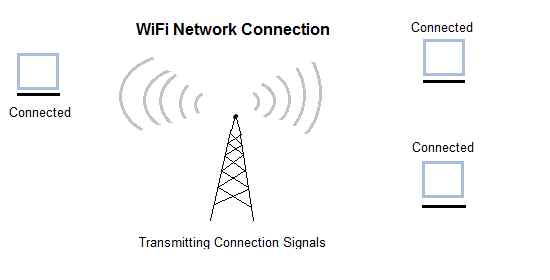
Inter Network
Inter Network or Internet is a combination of two or more networks. Inter network can be formed by joining two or more individual networks by means of various devices such as routers, gateways and bridges.

Connection Oriented and Connectionless Services
These are the two services given by the layers to layers above them. These services are:
- Connection Oriented Service
- Connectionless Services
Connection Oriented Services
There is a sequence of operation to be followed by the users of connection oriented service. These are:
- Connection is established.
- Information is sent.
- Connection is released.
In connection oriented service we have to establish a connection before starting the communication. When connection is established, we send the message or the information and then we release the connection.
Connection oriented service is more reliable than connectionless service. We can send the message in connection oriented service if there is an error at the receivers end. Example of connection oriented is TCP (Transmission Control Protocol) protocol.
Connection Less Services
It is similar to the postal services, as it carries the full address where the message (letter) is to be carried. Each message is routed independently from source to destination. The order of message sent can be different from the order received.
In connectionless the data is transferred in one direction from source to destination without checking that destination is still there or not or if it prepared to accept the message. Authentication is not needed in this. Example of Connectionless service is UDP (User Datagram Protocol) protocol.
Difference: Connection oriented and Connectionless service
- In connection oriented service authentication is needed, while connectionless service does not need any authentication.
- Connection oriented protocol makes a connection and checks whether message is received or not and sends again if an error occurs, while connectionless service protocol does not guarantees a message delivery.
- Connection oriented service is more reliable than connectionless service.
- Connection oriented service interface is stream based and connectionless is message based.
What are Service Primitives?
A service is formally specified by a set of primitives (operations) available to a user process to access the service. These primitives tell the service to perform some action or report on an action taken by a peer entity. If the protocol stack is located in the operating system, as it often is, the primitives are normally system calls. These calls cause a trap to kernel mode, which then turns control of the machine over to the operating system to send the necessary packets. The set of primitives available depends on the nature of the service being provided. The primitives for connection-oriented service are different from those of connection-less service. There are five types of service primitives :
- LISTEN : When a server is ready to accept an incoming connection it executes the LISTEN primitive. It blocks waiting for an incoming connection.
- CONNECT : It connects the server by establishing a connection. Response is awaited.
- RECIEVE: Then the RECIEVE call blocks the server.
- SEND : Then the client executes SEND primitive to transmit its request followed by the execution of RECIEVE to get the reply. Send the message.
- DISCONNECT : This primitive is used for terminating the connection. After this primitive one can't send any message. When the client sends DISCONNECT packet then the server also sends the DISCONNECT packet to acknowledge the client. When the server package is received by client then the process is terminated.
Connection Oriented Service Primitives
There are 5 types of primitives for Connection Oriented Service :
| LISTEN | Block waiting for an incoming connection |
| CONNECTION | Establish a connection with a waiting peer |
| RECEIVE | Block waiting for an incoming message |
| SEND | Sending a message to the peer |
| DISCONNECT | Terminate a connection |
Connectionless Service Primitives
There are 4 types of primitives for Connectionless Oriented Service:
| UNIDATA | This primitive sends a packet of data |
| FACILITY, REPORT | Primitive for enquiring about the performance of the network, like delivery statistics. |
Relationship of Services to Protocol
In this section we will learn about how services and protocols are related and why they are so important for each other.
What are Services?
These are the operations that a layer can provide to the layer above it in the OSI Reference model. It defines the operation and states a layer is ready to perform but it does not specify anything about the implementation of these operations.

What are Protocols?
These are set of rules that govern the format and meaning of frames, messages or packets that are exchanged between the server and client.
